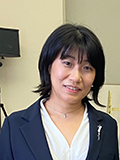Saeko Kita

Commendation
Research on the generation mechanisms of intraslab and slow earthquakes and seismotectonics in subduction zones
A list of five major papers
- Kita, S., T. Shiina, H. Houston and K. Shiomi (2024) Stress drops of intermediate-depth intraslab earthquakes beneath Tohoku, northern Japan. Earth, Planets and Space, 76 (1), 1-16.
- Kita, S., H. Houston, S. Yabe, S. Tanaka, Y. Asano, T. Shibutani and N. Suda (2021) Effects of episodic slow slip on seismicity and stress near a subduction-zone megathrust. Nature Communications, 12, 7253.
- Kita, S., A. Hasegawa, J. Nakajima, T. Okada, T. Matsuzawa and K. Katsumata(2012)High-resolution seismic velocity structure beneath the Hokkaido corner, northern Japan: Arc-arc collision and origins of the 1970 M 6.7 Hidaka and 1982 M 7.1 Urakawa-oki earthquakes. Journal of Geophysical Research, 117, B12301.
- Kita, S., T. Okada, A. Hasegawa, J. Nakajima and T. Matsuzawa(2010b)Existence of interplane earthquakes and neutral stress boundary between the upper and lower planes of the double seismic zone beneath Tohoku and Hokkaido, northeastern Japan. Tectonophysics, 496, 68-82.
- Kita, S., T. Okada, J. Nakajima, T. Matsuzawa and A. Hasegawa(2006)Existence of a seismic belt in the upper plane of the double seismic zone extending in the along-arc direction at depths of 70-100 km beneath NE Japan. Geophysical Research Letters, 33, L24310, 1-5.
Major achievements
Dr. Saeko Kita has established a unique approach that combines petrology and geology with seismic tomography as the mainstay of her work, and has established a strong presence in the field. She has achieved important results regarding the structure of the interior of the subducted oceanic plate and the mantle above it, and its relationship to earthquake occurrence. For example, she has pointed out the relationship between the geological features of the upper plate in the Hokkaido region and frequent occurrence of earthquakes beneath the Hidaka Mountains. The regional diversity of intraslab earthquakes was also discussed based on the change in effective strength of rocks due to dehydration reactions caused by temperature and pressure changes, Furthermore, she clarified the relationship between slow-slip events, seismic activity, and fluid pressure transfer, and proposed a new monitoring method for great earthquakes in subduction zones. In addition to these interdisciplinary research, she has been actively leading international collaborative research, providing research guidance to JICA trainees, and training future female researchers. Dr. Kita, who has pursued various activities while raising a child, deserves to be honored as a role model for female researchers.
[ ORCiD ]
[ Google Scholar ]
Recommender
Akira Hasegawa
Supporters
Gaku Kimura, Heidi Houston
